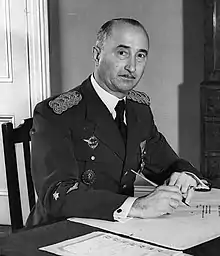Dušan Simović
Dušan Simović (Serbian: Душан Симовић; 28 October 1882 – 26 August 1962) was a Yugoslav Serb general who served as Chief of the General Staff of the Royal Yugoslav Army and as the Prime Minister of Yugoslavia in 1940–1941.[1]
Dušan Simović | |
|---|---|
 | |
| 14th Prime Minister of Yugoslavia | |
| In office 27 March 1941 – 11 January 1942 | |
| Monarch | Peter II Prince Paul (Regent, 1941) |
| Preceded by | Dragiša Cvetković |
| Succeeded by | Slobodan Jovanović |
| Personal details | |
| Born | 28 October 1882 Kragujevac, Serbia |
| Died | 26 August 1962 (aged 79) Belgrade, PR Serbia, Yugoslavia |
| Citizenship | Yugoslav |
| Spouse(s) | Snežana Tadić |
| Children | 4 daughters and 3 sons |
| Occupation | Soldier, politician |
| Military service | |
| Allegiance | |
| Branch/service | Royal Yugoslav Army |
| Years of service | 1900–1943 |
| Rank | Army general (Kingdom of Yugoslavia) |
| Commands | Royal Yugoslav Air Force Chief of the General Staff |
Life and career
Simović was born on 28 October 1882 in Kragujevac. He attended elementary school and two years of high school in his hometown. Due to his interest in military matters, he left high school and entered the military academy in Belgrade. He completed Military Academy in 1900, when he was promoted to second lieutenant of artillery. He completed the Higher School of Military Academy in 1905. During the Balkan Wars (1912–13) and during the First World War (1914–18), he proved to be an excellent officer, and was promoted in 1913, and again in 1915, to lieutenant colonel.[2] At the Salonika front, he was the commander of the 7th Infantry Regiment. But even in Thessalonica front, Simović was interested in the air force and air defense. Every day, he became more and more interested in the works of flight pioneer Mihailo Petrović, reading Petrović's reports in the Balkan Wars, as well as his studies on aviation. So he decided to dedicate his life to aviation. In 1918, he was named to the delegates of the Serbian government and the Joint Chiefs of Staff at the National Council of Slovenes, Croats and Serbs in Zagreb. Up to the onset of World War II he devoted himself exclusively to aviation.[3]
From May 1938 until 1940, he served as chief of general staff, in which position he replaced General Milutin Nedić. He joined other officers in a coup against the government of Dragiša Cvetković. After the coup, Simović became the new prime minister. He did not have much time to prepare for the coming war. On the wedding day of his daughter, Nazi Germany invaded Yugoslavia on 6 April 1941.[4]
Simović fled the country with his family. On 28 October 1941 Simović sent a message to the commander of the Chetniks, Draža Mihailović, and urged him to avoid premature actions and avoid reprisals.[5]
After the end of World War II and the formation of Tito's second Yugoslavia, he returned to Belgrade from London in June 1945. After the war ended he was a witness against Draža Mihailović at the latter's trial, and went on to author a number of books on military issues. He died in Belgrade in 1962.
He was married to Snežana Tadić (1883–1971), a Serbian-Ukrainian-Croatian pharmacist from Valjevo, and daughter of Milorad Tadić (1861–1940), in October 1908. They had three sons and four daughters.[6]
References
- A. W. Palmer, "Revolt in Belgrade, March 27, 1941,"History Today (March 1960) 10#3 pp 192-200.
- Dusan Biber, "The Yugoslav Coup d'État, 27 March 1941" in John Erickson and David Dilks (eds), Barbarossa: The Axis and the Allies (Edinburgh University Press, 1994), pp.34-42
- Dusan Biber, "The Yugoslav Coup d'État, 27 March 1941" in John Erickson and David Dilks (eds), Barbarossa: The Axis and the Allies (Edinburgh University Press, 1994), pp.34-42
- Germany and the 2nd World War Volume III: The Mediterranean, south-east Europe, and north Africa, 1939-1941, Gerhard Schreiber, Bernd Stegemann, Detlef Vogel, 1995, p. 484
- (Karchmar 1973, p. 241)
- Obituary, The New York Times (28 August 1962); "Gen. Simovic Dies; Yugoslav Leader; Headed Royal Government When Nazis Invaded in '41."
Sources
- Karchmar, Lucien (1973). Draz̆a Mihailović and the Rise of the C̆etnik Movement, 1941-1942. Department of History, Stanford University.CS1 maint: ref=harv (link)
| Political offices | ||
|---|---|---|
| Preceded by Dragiša Cvetković |
Prime Minister of Yugoslavia 1941 – 1942 |
Succeeded by Slobodan Jovanović |
| Preceded by Office established |
Minister of the Air Force and Navy of the Yugoslav government-in-exile 1941–1942 |
Succeeded by Dragoljub Mihailović |
| Military offices | ||
| Preceded by Milutin Nedić |
Chief of the General Staff of the Yugoslav Royal Army 1938 – 1940 |
Succeeded by Petar Kosić |
| Preceded by Petar Kosić |
Chief of the General Staff of the Yugoslav Royal Army 1941 |
Succeeded by Danilo Kalafatović |
| Preceded by Petar Bojović |
Deputy Commander in Chief of the Yugoslavian Armed Forces 1941–1942 |
Succeeded by Petar Živković |
| Wikimedia Commons has media related to Dušan Simović. |